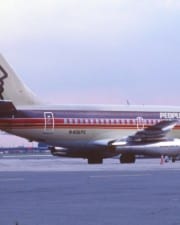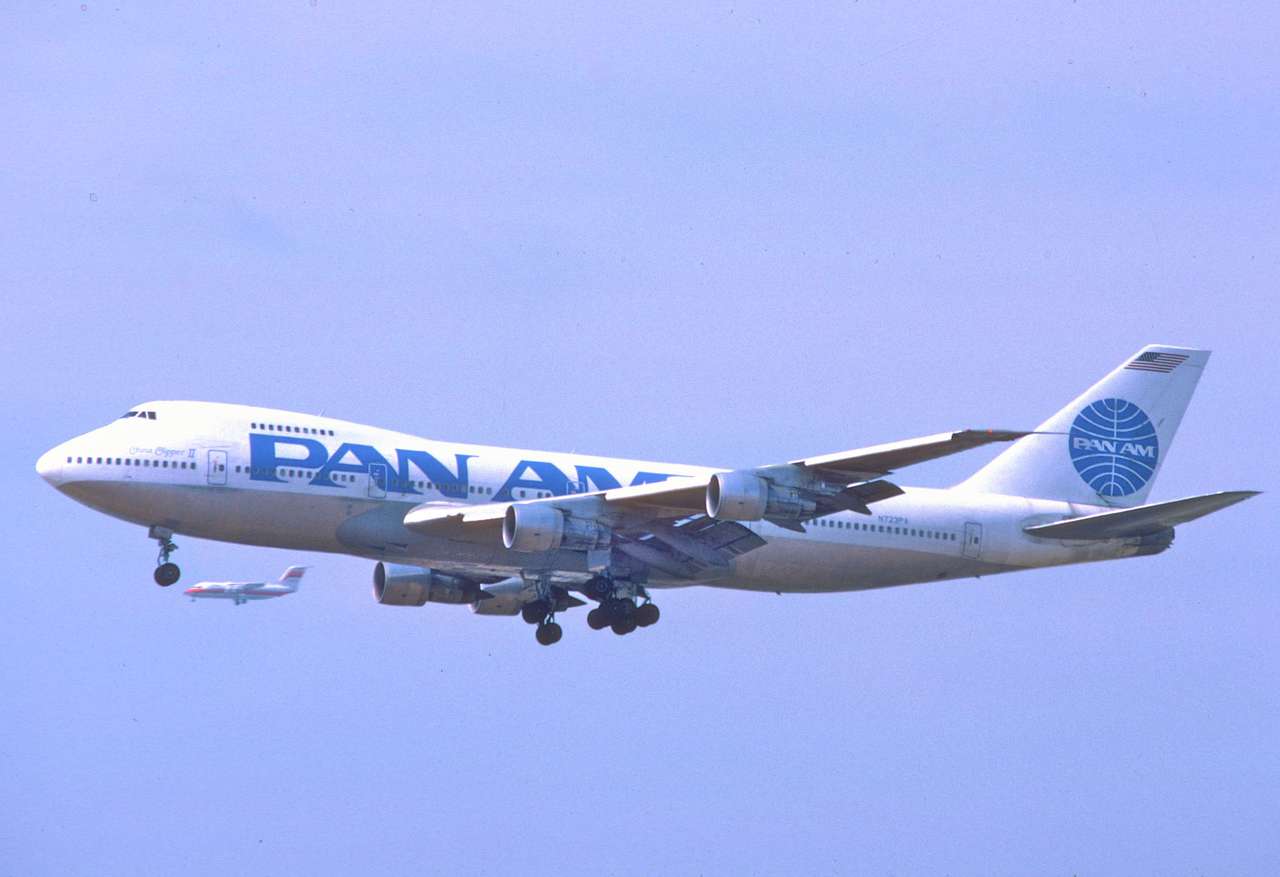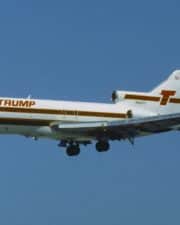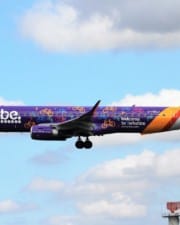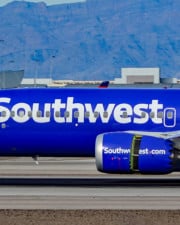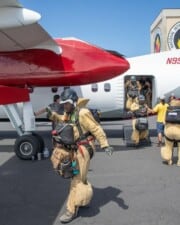If you had taken a domestic or international flight to or from America 50 years ago, TWA would’ve been one of the “Big Four” carriers from whom you had to choose. If you look for them today, there’s nothing. What happened?
Table of Contents
Well, for starters, it isn’t quite true that there’s nothing remaining of TWA. For those wondering who owns TWA now, that would be American Airlines: they merged (more like the latter bought out the former) in 2001.
Even so, it’s a shadow of what was once one of the biggest airlines in the world. The death of TWA involves terrorism, tragedy, changing times, an aging fleet, deregulation, ‘80s greed run amok, and two of the most famous (or infamous) mega-businessmen of all time.
In short, it’s a truly timeless international tale befitting a business named Trans World Airlines.
Let’s answer some of your questions about TWA first:
- When did TWA stop? It made its last flight on December 1, 2001.
- Who owns TWA now? American Airlines.
- Why did TWA go out of business? Read on…
1. The ‘30s, ‘40s, Howard Hughes, and Pan Am
In 1930, Trans World Airlines was born as the merger baby of Western Air Express and Transcontinental Air Transport. The fledgling airline began by delivering air by mail between Salt Lake City and Los Angeles and expanded from there, slowly adding commercial and eventually international flights by the ‘40s. Western Air Express would split off again in 1934, but TWA was here to stay (for now).

A few years later, Howard Hughes (pre-Crazy Rich Recluse phase) bought a controlling interest in the company. Hughes retained control of TWA for decades, even into his King Lear-esque latter day madness, until being forced out in 1960 and forced to sell shares in 1966.
Meanwhile, its international flights really “took off” from their inaugural route from New York to Paris in 1946 to routes all over North America, Europe, the Middle East, Africa, and Asia. True to its name, TWA was a trans-world airline and one of the biggest.
Those familiar with the airline industry might think this reminiscent of another classic airline, Pan Am. The two were nearly the same age with Pan Am being slightly older, formed in 1927 (though TWA’s predecessor Western Air Express was formed in 1925), and both followed the same air mail-to-international-flights model. They were great rivals and dominated this era of US airline travel.
2. The ‘50s, ‘60s, and the Jet Age
Both Pan Am and TWA also helped usher in the age of jet travel. Here again, the two airlines served as a case study in similar successful competing airlines. Even the nature of their boasting and branding was similar.
Pan Am loved to market itself as the “luxurious airline” but TWA was a keen rival in that department. While Pan Am ads stressed better food and luxuriant conditions, TWA broke ground by becoming the first airline to show in-flight movies in 1961.
In the ‘50s and ‘60s, both airlines prospered. After all, there was more than enough business to go around. In the 50s, more people were flying than ever before. This meant a big new pot of eager domestic and international passengers.

With TWA one of the best-established airlines in the country, they were in one of the best positions to capitalize on this newfound eagerness and accessibility to international travel.
In this era, TWA relied on large-scale Boeing 707s for both domestic and transatlantic flights. TWA was also a pioneer in terms of jet travel. The airline also helped usher in the jet age with the larger Boeing 707 for its transcontinental and transatlantic service.
For aviation history lovers, the first Boeing 707s in TWA’s fleet measured 145ft with a wingspan of 130ft. They tipped the scales at around 250,000lbs. TWA joined the jet age on March 20th, 1959 with a 707 flight from San Francisco to New York.
That said, these 707s were, shall we say, not exactly eco-friendly. Not only were they not at all fuel-efficient by modern standards but they were an ecological nightmare, pumping huge amounts of pollutants into the atmosphere.
That said, progress always has to start somewhere and with TWA embracing 707s, transatlantic flights from New York to London or Paris could be completed in six hours, which is less than half the time it took propeller-driven planes and thus earth shattering (or “air shattering”) for the time!
3. 1969 to 1986: Debt, Oil, Terrorism, and Unending Trouble
Still, all of this didn’t come without its fair share of trouble. Howard Hughes may have been one of America’s most famous (or infamous) mega-rich men but by now he was also starting to experience some of the signs of mental instability that would make him notorious. This, coupled with his earlier business dealings, spelled trouble for TWA.
Throughout the ‘60s, TWA had to deal with debt due to decisions made in the Hughes years. He was also a notorious micromanager, especially when it came to adapting to this new jet-fueled age. The result? TWA gained ground but not as fast as many of their competitors.
Hughes would be gone by the late ‘60s, but a new, far more sinister issue would emerge to cloud TWA’s future — terrorism.
While they were not the only ones experiencing this problem (long-time rival Pan Am also had several high profile attacks) TWA was notoriously unlucky in this regard. Between 1969 and 1986, the airline was the target of several notable terrorist attacks:
- 1969, TWA 740: A flight bound from Rome to Tel Aviv was hijacked by the Popular Front for the Liberation of Palestine. Two Israeli hostages were held for two months but eventually all 127 passengers were liberated and the hijackers apprehended.
- 1970, TWA 741: This was part of the Dawson’s Field Hijackings, in which five planes bound for New York and London were hijacked by the PFLP. Jewish passengers in particular were singled out for persecution. Luckily, all hostages on all planes were eventually evacuated safely.
- 1974, TWA 841: A bomb exploded on a flight bound from Tel Aviv to New York, killing 88 people.
- 1976, TWA 355: A flight bound from New York to Chicago was hijacked by five Croatian separatists claiming that they had a bomb. They flew to Newfoundland, Iceland, and Paris before confessing that their bomb was a fake.
- 1985: TWA 847: A flight from Rome to Athens was hijacked in Beirut. Flying back and forth between Beirut and Algiers, the hijackers beat and tortured passengers, killing one, US Navy sailor Robert Strethem. The USS Strethem is named in his honor.
- 1986, TWA 840: A plastic explosive went off on another flight from Rome to Athens. Four were killed and nine wounded. Luckily, the pilot was still able to make a landing, saving the rest of the passengers. The Abu Nidal Organization, another Palestinian terrorist organization, was deemed the likely criminals.
No amount of economic devastation can ever truly match the human cost of such crimes. Even so, TWA was devastated by the stain on their public reputation that came with these attacks. After all, those are a lot of attacks and the public became spooked. It may not have been their fault but it helped tank the TWA brand.
Finally, as you may have noticed, several of those hijackings were linked to Palestinian terrorist groups within the broader Israeli-Palestinian conflict. This was (and remains) quite hot, and in the ‘70s, it resulted in Arab states placing oil embargoes on the US.
If you were around at the time, you likely remember how bad the oil and gas rationing got. For companies that relied heavily on oil, such as airlines (especially already-vulnerable ones like TWA), this had a crippling effect.
4. 1978: Deregulation Hits TWA Hard
If you know anything about Washington over the past few decades, you know that getting any kind of bipartisan deal through Congress is notoriously tough. Fortunately, on rare occasions, it still happens. Unfortunately, one such occasion helped kill airlines such as Pan Am and TWA.
While we rightly remember the Reagan era of one of massive deregulation and the skyrocketing profits and income inequality that came with it, the 1978 Airline Deregulation Act was a prelude to that. Prior to that, the cost of plane tickets was much more closely regulated by the US government. Now, it was a free-for-all.
On the one hand, politics aside, this act did (for the moment) improve and incentivize airline competition. On the other hand, if there’s one thing that struggling airlines such as TWA and rival oldie airline Pan Am couldn’t afford right now, it was competition taking sorely needed profits amidst already-mounting losses.
5. 1984 to 1992: Carl Icahn Helps Kill an Icon
Terrorism, deregulation, and oil trouble not enough? Try having one of the most notorious “corporate raiders” of all-time as your boss. Carl Icahn is a polarizing figure, admired and loathed for his nigh-Ayn Randian self-interest. In venture after venture, he often comes out richer but leaving a poorer place behind.
Take TWA, for example. In 1984, TWA was already struggling for the reasons we’ve mentioned. What it needed was stability and investment. What it got was a leader more interested in how its assets could net him massive short-term gain rather than how he could achieve long-term sustainability.

A perfect example of this is how Icahn handled TWA’s London routes. These were some of, if not most of, the most profitable routes that TWA operated and one of its few remaining lifelines.
Just as with Pan Am, which was also being forced to sell off some routes and focus on other transatlantic options, TWA’s business model seemed to really need these London routes to survive.
But Carl Icahn didn’t see it that way. He sold off these routes to American Airlines in 1991, cutting off one of TWA’s biggest sources of revenue for $455 million. Lest you think that was done solely to save TWA’s fortunes, remember Icahn’s reputation as a “corporate raider.”
When Icahn bought 20% of TWA’s stock in 1985, gaining control, he proceeded to enrich himself by taking the company private, pocketing $469 million while leaving the company with $540 million in debt.
Not only does that demonstrate just how badly Icahn ravaged his own company, it further illustrates how badly it needed those London routes to survive and how savage a self-interested death blow selling them off was at the time.
This was easily one of the most destructive moves in torpedoing TWA’s chances of survival. While we might ask what killed TWA, a better question may be who, and the best answer may be Carl Icahn.
That’s certainly how eBay board member Marc Andeersen sees it. In a 2014 blog post (now archived on Business Insider) he characterizes Icahn’s acquisition of the company as “a sneak attack” while discussing how he “systematically stripped it of its assets.”

By the ‘90s, Icahn had effectively picked TWA’s carcass clean. He was gone by 1993 but much of TWA’s former glory and hope for the future had gone with him.
Chances are that if you came into this wondering “Why did TWA go out of business?”, you have your answer now.
6. 1993 to 2001: Last Days and the Sale to American Airlines
Things would only get worse for TWA as another old tragedy reemerged — explosions on flights. On July 17th, 1996, TWA 800 bound from New York to Paris exploded, killing all 230 people on board. While it was ruled an accident (likely the result of a spark from the fuel tank), reviving memories of old TWA horror stories was the last thing that the ailing, struggling company needed.
It may not have been the official last straw but it was a symbolic nail in a coffin decades in the making. Given the likely cause of the accident, part of the media coverage and blame fixated on TWA’s once-revolutionary but now aging fleet.
By now, Pan Am, beset by similar issues, had gone under, liquidated in 1991. Following some huge losses in its last years and another insulting (or hilarious) attempt by Carl Icahn to buy the company, TWA entered talks with prospective buyers. With 9/11 killing the travel industry for months, needless to say, TWA wouldn’t survive and was finally sold in 2001.
When did TWA stop? It made its last flight on December 1, 2001. To add insult to injury, who owns TWA now? American Airlines — the company to which Icahn had auctioned off those lucrative London routes all those years ago.
References ▾
- https://www.congress.gov/bill/95th-congress/senate-bill/2493/cosponsors?searchResultViewType=expanded&KWICView=false
- https://www.investopedia.com/financial-edge/0610/dead-airlines-and-what-killed-them.aspx
- https://www.stlmag.com/TWA-Death-Of-A-Legend
- https://www.britannica.com/topic/Trans-World-Airlines-Inc
- https://traveltips.usatoday.com/twa-airlines-history-21998.html
- https://www.pbs.org/wgbh/americanexperience/films/hijacked
- https://archives.law.virginia.edu/dengrove/writeup/croatian-nationalists-trial-1976-hijacking-twa-flight-355
- https://www.history.com/this-day-in-history/twa-flight-847-is-hijacked-by-terrorists
- https://www.nytimes.com/1986/04/03/world/4-killed-as-bomb-rips-twa-plane-on-way-to-athens.html?ref=oembed
- https://www.airlineratings.com/news/twas-first-boeing-707/
Related Posts


